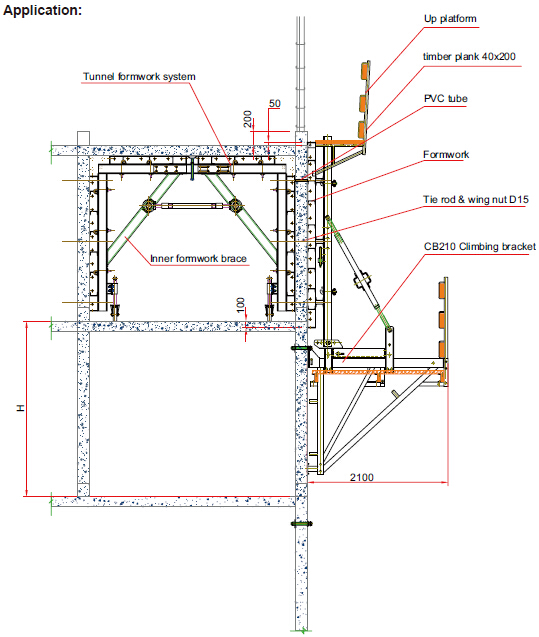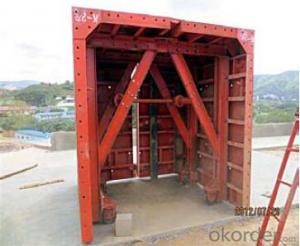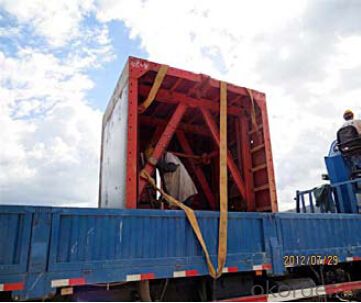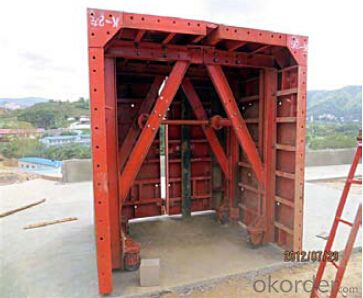Steel tunnel for formwork and scaffolding system
- Loading Port:
- Tianjin
- Payment Terms:
- TT OR LC
- Min Order Qty:
- 50 m²
- Supply Capability:
- 1000 m²/month
OKorder Service Pledge
Quality Product, Order Online Tracking, Timely Delivery
OKorder Financial Service
Credit Rating, Credit Services, Credit Purchasing
You Might Also Like
Building Tunnel Formwork:
A compositional steel formwork system mainly used in the building which has regular structure
without beams, the excellent formwork system can make the integral pouring for the wall & slab
easily achieved.
Characteristics:
◆ High stiffness, make perfect shape for concrete.
◆ Easy operation, save labor and force.
◆ Fast forming, repeatedly turnover.

- Q: How does steel formwork contribute to the strength of the structure?
- Steel formwork contributes to the strength of a structure in several ways. Firstly, steel is a strong and durable material, making it ideal for withstanding the pressures and loads that a structure may experience. This strength allows the formwork to support the weight of the concrete during the pouring and setting process, ensuring that it does not collapse or deform under the weight. Additionally, steel formwork provides excellent stability and support, which is crucial for the overall stability of the structure. The rigidity of steel formwork prevents any shifting or movement during the curing process, ensuring that the concrete sets in the desired shape and maintains its structural integrity. Moreover, steel formwork is highly resistant to moisture, chemicals, and extreme weather conditions. This resistance helps to protect the concrete from any potential damage or deterioration that may occur over time, ensuring the longevity and strength of the structure. Another essential aspect of steel formwork is its ability to create smooth and precise concrete surfaces. The use of steel panels and beams with smooth finishes allows for a high level of accuracy and precision in the construction process. This precision translates into a more robust and structurally sound finished product. Furthermore, steel formwork is reusable, which contributes to its cost-effectiveness and sustainability. The ability to reuse the formwork multiple times reduces construction costs and minimizes waste, making it an environmentally friendly option. In summary, steel formwork plays a crucial role in enhancing the strength of a structure. Its strength, stability, resistance to various elements, precision, and reusability all contribute to creating a durable and robust structure that can withstand the test of time.
- Q: How does steel formwork impact the overall energy efficiency of a structure?
- Steel formwork can have a significant impact on the overall energy efficiency of a structure. Firstly, steel formwork is highly durable and can be used repeatedly, reducing the need for new formwork materials for each construction project. This reduces the energy consumption associated with manufacturing and transporting formwork materials. Furthermore, steel formwork is known for its excellent thermal conductivity, which allows for efficient heat transfer. This property is particularly important in structures where energy efficiency is a priority, such as residential or commercial buildings. Efficient heat transfer can help maintain a comfortable indoor temperature, reducing the need for excessive heating or cooling, and thus minimizing energy consumption. In addition, steel formwork can contribute to the overall insulation of a structure. By using insulating materials in combination with steel formwork, a building's thermal performance can be significantly improved. This insulation helps to prevent heat loss during colder months and heat gain during warmer months, reducing the reliance on artificial heating and cooling systems. Consequently, energy consumption is reduced, leading to improved energy efficiency. Moreover, steel formwork can be designed to incorporate features that enhance natural lighting and ventilation in a structure. By allowing more natural light to enter the building, the need for artificial lighting during daylight hours is reduced, resulting in lower energy consumption. Similarly, by promoting natural ventilation, steel formwork can reduce the need for mechanical ventilation systems, further contributing to energy efficiency. Lastly, steel formwork's strength and stability allow for the construction of innovative and energy-efficient structural designs. It enables the use of larger open spaces, reducing the need for additional structural components and materials. This not only reduces construction costs but also lowers energy consumption associated with the production and transportation of these additional materials. In conclusion, steel formwork positively impacts the overall energy efficiency of a structure through its durability, thermal conductivity, insulation properties, natural lighting and ventilation features, and its ability to enable innovative structural designs. By reducing energy consumption in various ways, steel formwork contributes to the sustainability and long-term energy efficiency of a building.
- Q: How is steel formwork different from other types of formwork?
- Steel formwork is different from other types of formwork primarily because it is made of steel, which offers several distinct advantages. Firstly, steel formwork is highly durable and can withstand heavy loads and repeated use without deformation or damage. This makes it ideal for use in large construction projects where formwork needs to be reused multiple times. Additionally, steel formwork is known for its exceptional strength and stability. It can support concrete walls and slabs without the need for additional support structures, reducing construction time and costs. Its rigidity also ensures that the formwork maintains its shape and prevents concrete from leaking or shifting during pouring and curing. Another significant advantage of steel formwork is its adaptability and versatility. It can be easily customized to meet different project requirements, allowing for the construction of complex shapes and designs. This flexibility makes steel formwork suitable for a wide range of applications, including high-rise buildings, bridges, tunnels, and even curved structures. Moreover, steel formwork offers excellent surface finish quality. Its smooth and even surface reduces the need for additional finishing works, saving time and resources. It also provides a uniform appearance to the finished concrete structure. In terms of cost-effectiveness, steel formwork may have a higher initial investment compared to other types of formwork, such as wood or aluminum. However, its durability and reusability offset the higher upfront costs in the long run. Additionally, the efficiency and speed of construction achieved with steel formwork can lead to significant time and labor savings, making it a cost-effective choice for large-scale projects. Overall, steel formwork stands out due to its durability, strength, adaptability, surface finish quality, and cost-effectiveness. These features make it a popular choice in the construction industry for projects that require a robust and reliable formwork system.
- Q: Can steel formwork be used for foundation walls?
- Yes, steel formwork can be used for foundation walls. Steel formwork provides excellent strength and durability, making it suitable for constructing sturdy foundation walls. It can effectively withstand the pressure exerted by the concrete during the pouring process and provide a smooth finish to the walls. Additionally, steel formwork is reusable, which makes it a cost-effective option for foundation wall construction.
- Q: Is steel formwork suitable for all types of construction projects?
- Steel formwork is a versatile and widely used construction material that is suitable for a variety of construction projects. However, it may not be suitable for all types of construction projects. Steel formwork offers several advantages such as durability, reusability, and high load-bearing capacity. It can be used for both large-scale and small-scale projects, including residential, commercial, industrial, and infrastructure projects. Steel formwork is particularly well-suited for projects that require a high degree of precision and quality finish, such as high-rise buildings, bridges, and tunnels. However, there are certain factors to consider when determining the suitability of steel formwork for a specific construction project. One important factor is the project's budget. Steel formwork tends to have a higher initial cost compared to other types of formwork materials such as timber or aluminum. Therefore, it may not be suitable for projects with tight budget constraints. Another factor to consider is the project's timeline. Steel formwork requires skilled labor and time for assembly, disassembly, and transportation. This may result in longer construction periods, which may not be feasible for projects with strict deadlines. The complexity of the project is also an important factor to consider. Steel formwork is highly adaptable and can be custom-made for specific project requirements. However, if the project involves irregular or complex shapes, it may be more challenging and time-consuming to construct steel formwork compared to other types of formwork materials. Additionally, the environmental conditions of the construction site should be taken into account. Steel formwork is durable and can withstand harsh weather conditions. However, it may not be suitable for projects in coastal areas or locations with high humidity, as steel is susceptible to corrosion. In conclusion, while steel formwork is suitable for a wide range of construction projects, its suitability should be evaluated on a case-by-case basis. Considerations such as budget, timeline, complexity of the project, and environmental conditions should be taken into account to determine if steel formwork is the most suitable choice for a specific construction project.
- Q: How does steel formwork compare to aluminum formwork in terms of performance?
- Steel formwork and aluminum formwork are two commonly used materials in the construction industry for creating temporary molds or structures that hold concrete in place until it hardens. While both materials have their advantages and disadvantages, it is important to consider their performance aspects when comparing them. In terms of performance, steel formwork is known for its strength and durability. It has a high load-bearing capacity, making it suitable for heavy-duty applications. Steel formwork can withstand extreme weather conditions, rough handling, and repetitive use without significant wear and tear. The rigidity of steel formwork ensures that the structure maintains its shape during the concrete pouring process, resulting in accurate and precise finishes. Additionally, steel formwork allows for easy customization and modification to meet specific project requirements. On the other hand, aluminum formwork is preferred for its lightweight nature, which makes it easy to handle, transport, and assemble. The lightweight nature of aluminum formwork reduces labor costs and speeds up construction time. It also boasts excellent corrosion resistance, making it suitable for projects near coastal areas or in humid environments. Furthermore, aluminum formwork provides a smooth surface finish on the concrete, requiring minimal or no surface treatment. While both steel and aluminum formwork have their own advantages, the choice between the two depends on the specific requirements of the project. If the project involves heavy loads or requires a high number of reuses, steel formwork should be considered due to its superior strength and durability. However, if the project demands quick assembly, easy handling, and a smooth surface finish, aluminum formwork would be a better choice. Ultimately, the selection of steel or aluminum formwork should be based on a careful evaluation of the project's needs, budget, and timeline. A thorough assessment of the performance aspects, as well as other factors such as cost, maintenance, and environmental impact, will help determine the most suitable formwork material for a particular construction project.
- Q: What are the different cost considerations associated with steel formwork?
- There are several cost considerations associated with steel formwork that need to be taken into account when planning a construction project. Firstly, there is the initial cost of purchasing or renting the steel formwork. Steel formwork is generally more expensive than other types of formwork, such as timber or plastic. However, it is important to note that steel formwork is durable and has a longer lifespan, which can offset the initial cost in the long run. Secondly, there are the labor costs associated with assembling and dismantling the steel formwork. Steel formwork requires skilled labor for proper installation and removal, which may incur additional expenses. However, steel formwork is typically faster to set up and dismantle compared to other types of formwork, which can potentially reduce labor costs. Another cost consideration is the maintenance and repair expenses. While steel formwork is known for its durability, it may still require occasional maintenance or repairs to ensure its optimal performance. This can include cleaning, painting, or replacing damaged components. These maintenance costs should be factored into the overall project budget. Additionally, transportation costs should be considered when using steel formwork. Steel formwork is heavy and bulky, requiring special transportation arrangements. This can lead to higher transportation costs compared to lighter and more compact formwork options. Lastly, the cost of formwork accessories, such as connectors, brackets, and ties, should also be taken into account. These accessories are necessary for proper formwork installation and can add to the overall cost of using steel formwork. In conclusion, the different cost considerations associated with steel formwork include the initial purchase or rental cost, labor costs for assembly and dismantling, maintenance and repair expenses, transportation costs, and the cost of formwork accessories. While steel formwork may have higher upfront costs, its durability, speed of installation, and long-term lifespan can provide cost-saving benefits in the long run.
- Q: What are the limitations of using steel formwork?
- Using steel formwork in construction projects has several limitations. Firstly, it is a relatively expensive option compared to materials like wood or aluminum, which can significantly increase construction costs for large-scale projects. Secondly, the heaviness of steel formwork necessitates the use of heavy machinery and equipment for transportation and installation. This can pose challenges in areas with limited access or on sites with uneven terrain. In addition, skilled labor is required for the proper installation and dismantling of steel formwork. If the workforce lacks experience in working with steel formwork, this can lead to delays and increased labor costs. Furthermore, steel formwork is not as flexible as other materials, which can limit design possibilities for complex or irregular shapes. Another drawback is the potential for corrosion. Steel formwork is susceptible to rust and corrosion, particularly in environments with high moisture or chemical exposure. Regular maintenance and corrosion protection measures are necessary to ensure the longevity of steel formwork. Lastly, steel formwork is not as environmentally friendly as other alternatives. The production of steel involves significant energy consumption and carbon emissions, contributing to environmental degradation. Overall, while steel formwork offers strength and durability, it is important to carefully consider its limitations in terms of cost, weight, flexibility, corrosion susceptibility, and environmental impact before selecting it for construction projects.
- Q: What are the considerations when designing steel formwork for underground utilities?
- There are several essential factors to consider when designing steel formwork for underground utilities. These considerations encompass: 1. Structural Integrity: It is necessary to ensure that the formwork can withstand the pressure and forces exerted by the surrounding soil and any potential external loads. The design should offer sufficient strength and stability throughout the construction process. 2. Water and Chemical Resistance: Underground utilities are often exposed to water and various chemicals. Consequently, the formwork must be designed to resist corrosion and deterioration caused by these elements, ensuring its durability. 3. Accessibility for Installation and Maintenance: The formwork design should facilitate easy access during installation and future maintenance activities. This may involve incorporating provisions for openings, removable sections, or access points to allow workers to easily reach the utilities when necessary. 4. Modular Design: Utilizing a modular design can provide flexibility and simplify installation. Modular formwork systems enable quick assembly and disassembly, which proves advantageous when dealing with different underground utility layouts and configurations. 5. Safety: Safety is of utmost importance in any construction project. Therefore, the formwork design should include safety features such as guardrails, handrails, and anti-slip surfaces to minimize the risk of accidents and injuries during construction and maintenance. 6. Cost-effectiveness: The design should strike a balance between performance and cost. It should be optimized to minimize material usage and labor costs while maintaining quality and durability. 7. Compatibility with other construction methods: The design should be compatible with other construction methods and materials used for the underground utilities. This encompasses considerations for joining techniques, such as welding or bolting, and compatibility with other materials, such as concrete or PVC pipes. By taking these factors into account, designers can ensure that the steel formwork for underground utilities is structurally sound, resistant to environmental factors, easily accessible for installation and maintenance, safe for workers, cost-effective, and compatible with other construction methods.
- Q: Is steel formwork suitable for projects with high concrete strength requirements?
- Indeed, steel formwork proves to be a fitting choice for endeavors demanding robust concrete potency. Renowned for its exceptional fortitude and endurance, steel formwork emerges as an ideal candidate for projects necessitating elevated concrete strength. It deftly endures the concrete's pressure and weight, assuring steadfastness and structural integrity throughout the pouring and curing phases. Furthermore, steel formwork grants the concrete a seamless and uniform surface, crucial in attaining superior strength and excellence in the ultimate outcome. Moreover, the reusability of steel formwork renders it a cost-efficient alternative for ventures requiring substantial concrete strength.
Send your message to us
Steel tunnel for formwork and scaffolding system
- Loading Port:
- Tianjin
- Payment Terms:
- TT OR LC
- Min Order Qty:
- 50 m²
- Supply Capability:
- 1000 m²/month
OKorder Service Pledge
Quality Product, Order Online Tracking, Timely Delivery
OKorder Financial Service
Credit Rating, Credit Services, Credit Purchasing
Similar products
Hot products
Hot Searches
Related keywords

















